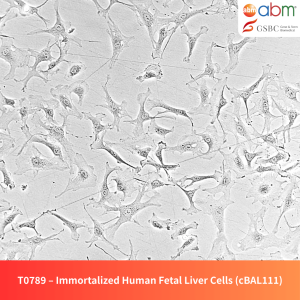Product Details
- Catalog Number: T0281
- Unit Size: 1 x 10⁶ cells / 1.0 mL
- Species: Human (Homo sapiens)
- Tissue: Brain
- Donor Information: 18 weeks gestation
- Cell Type: Immortalized astrocytes
- Growth Properties: Adherent, multipolar
- Biosafety Level: BSL-2
- Storage: Vapor phase of liquid nitrogen (< -130°C)
- Shipping: Shipped on dry ice
- Format: Cryopreserved frozen cells
Overview
Immortalized Human Astrocytes, Fetal – hTERT provide a robust platform for investigating astrocytic roles in neurobiology. These cells have been immortalized using hTERT to support long-term expansion while maintaining their physiological properties. Astrocytes are crucial for neuroprotection, synaptic plasticity, and inflammatory responses in the central nervous system. This cell line is ideal for neurodegenerative disease research, neuroinflammation studies, and drug screening applications.
Key Features and Benefits
- Long-Term Viability: hTERT immortalization ensures extended culture without senescence.
- Reproducibility: Stable characteristics across multiple passages for consistent experimental results.
- Ideal for Neurobiology Research: Supports studies on neuroinflammation, synaptic plasticity, and neuron-glial interactions.
- Optimized Growth Conditions: Adapted for specific media and extracellular matrices to maintain physiological functionality.
- Adherent Growth Properties: Easy maintenance and handling in standard culture conditions.
Culture & Handling Guidelines
Recommended Culture Conditions
- Coating: Use PriCoat™ ECM T25 Flasks (G999) or Applied Cell Extracellular Matrix (G422) for optimal adhesion.
- Growth Medium: PriGrow IV (TM004) supplemented with:
- 10% Fetal Bovine Serum (FBS)
- 2mM L-Glutamine (G275)
- 10ng/mL Recombinant Human EGF (Z100139)
- 1% Penicillin/Streptomycin Solution (G255)
- Incubation Conditions: 37°C in a humidified atmosphere with 5% CO₂.
- Seeding Density: 20,000 – 40,000 cells/cm².
- Doubling Time: 36 – 46 hours.
Thawing Protocol
- Quickly thaw cells in a 37°C water bath (maximum 2 minutes) while keeping the vial cap above water to prevent contamination.
- Decontaminate the vial by spraying with 70% ethanol and transfer to a biosafety cabinet.
- Transfer thawed cells to a 15mL sterile conical tube containing 5mL of pre-warmed complete growth medium.
- Centrifuge at 125xg for 5-7 minutes.
- Aspirate the supernatant, resuspend the pellet in fresh medium, and seed into a pre-coated T25 flask.
- Incubate under recommended conditions and allow cells to recover before passaging.
Subculturing Guidelines
- Aspirate old medium and rinse cells with PBS.
- Add 2-3mL of pre-warmed 0.25% Trypsin-EDTA and incubate at 37°C until cells detach (approximately 2-10 minutes).
- Neutralize trypsin by adding an equal volume of complete medium.
- Centrifuge at 125xg for 5 minutes, aspirate the supernatant, and resuspend the pellet in fresh growth medium.
- Seed cells at the appropriate density into new culture vessels.
- Incubate under recommended conditions and monitor for confluency.
Cryopreservation Guidelines
- Cryopreservation Medium: Use Cryopreservation Medium (TM024) or complete growth medium supplemented with 10% DMSO.
- Freezing Protocol: Freeze at a controlled rate (-1°C per minute) before transferring to liquid nitrogen storage.
STR Profiling (Short Tandem Repeat Analysis)
- D5S818 : 11,13
- D13S317 : 12,12
- D7S820 : 10,11
- D16S539 : 13,13
- VWA : 16,17
- TH01 : 6,9.3
- AMEL : X,X
- TPOX : 11,11
- CSF1PO : 11,11
- D12S391 : 16,19
- FGA : 22,22
- D2S1338 : 17,24
- D21S11 : 29,29
- D18S51 : 15,16
- D8S1179 : 13,13
- D3S1358 : 16,17
- D6S1043 : 14,20
- PENTAE : 12,13
- D19S433 : 13,14
- PENTAD : 12,12
- D1S1656 : 16,18.3
Related Products
- Recombinant Human Transforming Growth Factor Alpha (TGF-α) – Z101935
- Recombinant Human Fibroblast Growth Factor 2 (FGF2, E. coli) – Z101455
Disclaimer
- This product is intended for research use only. Not for diagnostic, therapeutic, or clinical applications.
- Users should ensure compliance with institutional biosafety regulations when handling and culturing cells.
- Performance and results may vary depending on culture conditions and experimental protocols.
- No warranties, express or implied, are provided for the suitability of this product for specific applications.
Reference
- Agnihotri, Sameer, et al. “Ketoconazole and posaconazole selectively target HK2-expressing glioblastoma cells.” Clinical Cancer Research 25.2 (2019): 844-855.
- Baskin, Rebekah, et al. “Functional analysis of the 11q23. 3 glioma susceptibility locus implicates PHLDB1 and DDX6 in glioma susceptibility.” Scientific reports 5.1 (2015): 17367.
- Dozio, Vito, and Jean-Charles Sanchez. “Profiling the proteomic inflammatory state of human astrocytes using DIA mass spectrometry.” Journal of neuroinflammation 15 (2018): 1-14.
- Erkan, E. P., et al. “Depletion of minichromosome maintenance protein 7 inhibits glioblastoma multiforme tumor growth in vivo.” Oncogene 33.39 (2014): 4778-4785.
- Prabhu, Antony, et al. “Targeting the unfolded protein response in glioblastoma cells with the fusion protein EGF-SubA.” PLoS One 7.12 (2012): e52265.
- Sundstrøm, Terje, et al. “Inhibition of mitochondrial respiration prevents BRAF-mutant melanoma brain metastasis.” Acta neuropathologica communications 7 (2019): 1-19.
- Blackman, Marine CNM, et al. “Mitochondrial protein Cox7b is a metabolic sensor driving brain-specific metastasis of human breast cancer cells.” Cancers 14.18 (2022): 4371.




